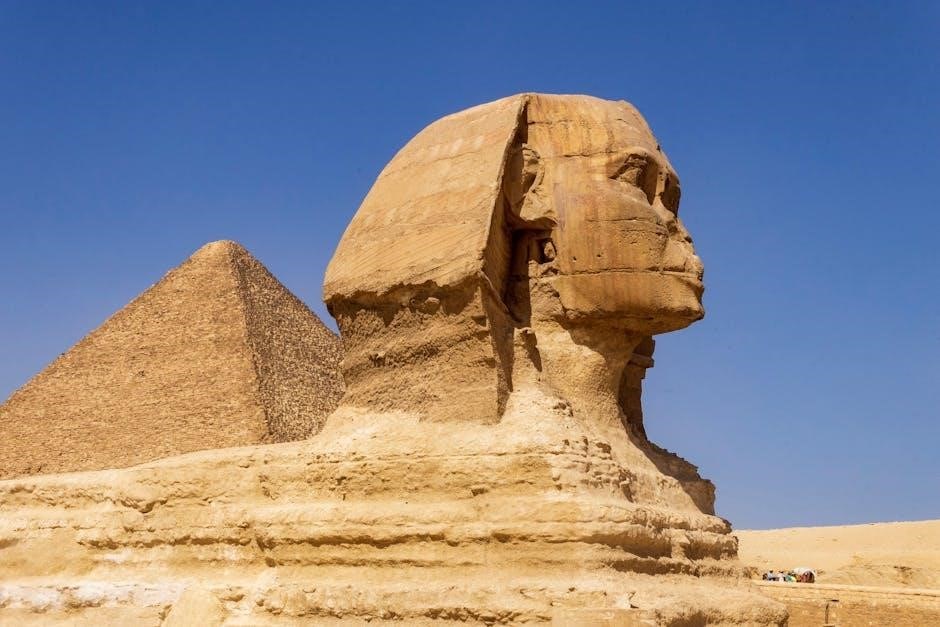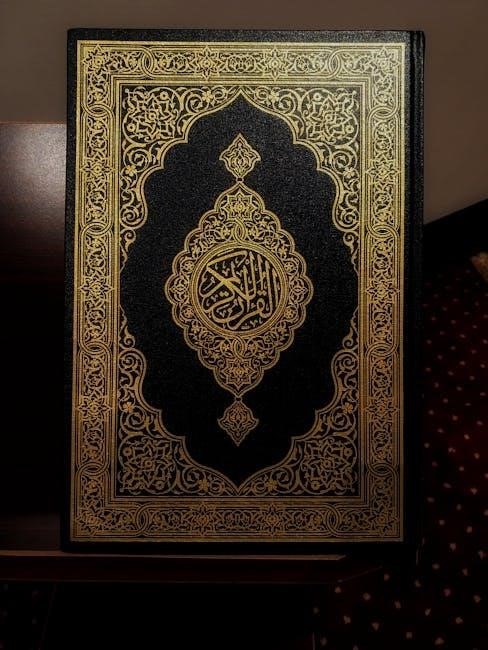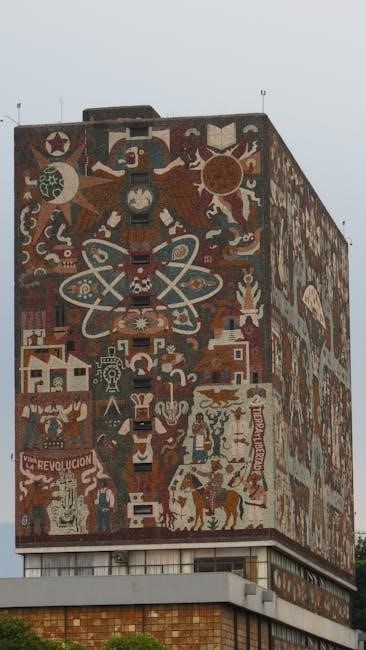
This comprehensive guide provides strategies, resources, and insights to master the AP World History exam, covering key periods, themes, and practice questions for optimal preparation.
1.1 Overview of the AP World History Exam
The AP World History exam assesses understanding of global processes and historical events from c. 1200 to the present. It is divided into two sections: Section I includes multiple-choice and short-answer questions, while Section II features document-based questions and a long essay. The exam emphasizes six key themes: patterns of interaction, ideologies, governance, economy, science, and culture. Students must demonstrate analytical skills, historical reasoning, and the ability to synthesize information. The test is scored on a scale of 1 to 5, with 5 indicating exceptional mastery. Preparation requires a deep understanding of historical periods, regional interactions, and thematic connections across time and place.

1.2 Importance of Using a Study Guide
A study guide is essential for effectively preparing for the AP World History exam, as it provides a structured approach to understanding the vast scope of global history. It helps students grasp key themes, periods, and regional interactions, ensuring they are well-versed in the exam’s content. By breaking down complex topics into manageable sections, a study guide simplifies learning and enhances retention. It also offers strategies for tackling multiple-choice, short-answer, and essay questions, reducing exam anxiety. Additionally, study guides often include practice exams and detailed reviews, allowing students to assess their knowledge and identify areas for improvement. Utilizing a study guide ensures a focused and efficient study routine, ultimately boosting confidence and performance on test day.
1.3 How to Maximize the Use of This Guide

To maximize the effectiveness of this guide, start by reviewing the exam structure and content outline. Focus on understanding the key historical periods and themes, such as the Global Tapestry, Networks of Exchange, and Global Conflict. Utilize the practice questions and model essays to refine your test-taking skills. Regularly review and annotate the guide to reinforce your understanding of critical concepts. Additionally, incorporate active learning techniques, such as summarizing key points in your own words and engaging in group discussions. By systematically working through each section and aligning your study habits with the guide’s recommendations, you can ensure a comprehensive and successful preparation for the AP World History exam.
Understanding the AP World History Exam Format
Understand the exam’s two sections: multiple-choice and short answers (Section I) and document-based and long essay questions (Section II). Mastering time management is crucial for success.

2.1 Structure of the Exam
The AP World History exam is divided into two main sections. Section I includes multiple-choice and short-answer questions, testing factual knowledge and analytical skills. Section II features document-based and long essay questions, focusing on historical reasoning and synthesis. Each section is timed, with 60 minutes for Section I and 130 minutes for Section II. The exam evaluates understanding of global processes, historical themes, and evidence-based analysis. Scores range from 1 to 5, with higher scores qualifying for college credit. Familiarity with the structure is essential for effective time management and strategic answering. Understanding the format helps students allocate time wisely and address each question type confidently.
2.2 Types of Questions and Their Weightage
The AP World History exam features four types of questions: multiple-choice, short-answer, document-based, and long essay. Multiple-choice questions account for 40% of the score, testing factual knowledge and interpretive skills. Short-answer questions (20%) require concise analysis and evidence-based responses. Document-based questions (25%) assess the ability to synthesize historical documents and develop arguments. Long essays (15%) evaluate thematic understanding and historical reasoning. Each question type targets specific skills, such as analysis, comparison, and evidence-based argumentation. Understanding the weightage ensures focused preparation, as document-based and essay questions carry higher weight. Practice with each format is crucial for achieving a high score.
2.3 Time Management Strategies
Effective time management is critical for success on the AP World History exam. Allocate 60 minutes for Section I (multiple-choice and short-answer questions) and 120 minutes for Section II (document-based and long essay questions). During the 15-minute reading period for Section II, skim documents and plan essays. Focus on high-weight questions first, such as the document-based question, to maximize points. Practice under timed conditions to build stamina and efficiency. Avoid spending excessive time on a single question; move forward and revisit skipped questions later. Regular practice with past exams helps refine pacing and ensures optimal performance on test day. Prioritize clarity and conciseness in responses to meet time constraints.
Key Historical Periods Covered in the Exam
The exam covers four main periods: The Global Tapestry (1200-1450), Networks of Exchange (1450-1750), Consequences of Industrialization (1750-1900), and Global Conflict (1900-Present), each emphasizing distinct historical themes and developments.
3.1 The Global Tapestry (c. 1200 to c. 1450)

This period explores the interconnectedness of societies across Afro-Eurasia and the Americas, highlighting developments in East Asia, Dar al-Islam, and South Asia. Key themes include the rise of empires like the Mongols, maritime trade networks, and the spread of religions such as Buddhism and Islam. The Mongol Empire’s expansion facilitated cultural and economic exchanges, while regional kingdoms like the Delhi Sultanate and the Ming Dynasty flourished. The Black Death’s impact and the decline of the Mongol Empire marked the end of this era. Understanding these dynamics is crucial for analyzing the foundational structures of global history and their lasting legacies.
3.2 Networks of Exchange (c. 1450 to c. 1750)
This period emphasizes the expansion of global trade networks, including the Columbian Exchange and the rise of maritime empires. European explorers established new sea routes, connecting the Americas to Afro-Eurasia, leading to the exchange of crops, diseases, and cultures. The Manila Galleons and the Silk Road facilitated the transfer of goods like silver, spices, and textiles. Meanwhile, the Ottoman and Ming empires controlled vast trade networks, while African kingdoms like Kongo participated in the Atlantic economy. These exchanges reshaped demographics, economies, and societies, laying the groundwork for global interconnectedness and the rise of European dominance in trade and colonization.
3.3 Consequences of Industrialization (c. 1750 to c. 1900)
Industrialization transformed societies by shifting economies from agrarian to machine-based production. The development of steam engines, railways, and factories revolutionized industries like textiles and manufacturing. Urbanization accelerated as workers moved to cities for employment, leading to the growth of a working class. However, industrialization also brought environmental degradation, poor working conditions, and social inequality. Global trade patterns shifted, with industrialized nations exploiting resources from colonized regions. This period saw the rise of imperialism, as industrialized powers sought raw materials and markets. The consequences of industrialization reshaped global economies, societies, and environments, creating both opportunities and challenges that shaped the modern world.
3.4 Global Conflict (c. 1900 to Present)

The 20th and 21st centuries were marked by devastating global conflicts, starting with World War I (1914–1918) and World War II (1939–1945), which reshaped political landscapes and caused unprecedented human suffering. The Cold War (1947–1991) introduced a new era of ideological tension, while decolonization led to independence movements worldwide. Modern conflicts, such as the Gulf Wars and ongoing regional disputes, highlight issues like terrorism, resource competition, and geopolitical instability. These events underscore the complexities of nationalism, imperialism, and technological advancements in warfare, emphasizing their profound impacts on global societies and economies.

Effective Study Strategies

Active learning, practice exams, and structured note-taking are essential. Focus on understanding themes, causation, and historical evidence to excel in the AP World History exam.
4.1 Breaking Down the Curriculum
Breaking down the AP World History curriculum involves organizing nine units into manageable sections. Start with the Global Tapestry (1200-1450), focusing on East Asia, Dar al-Islam, and Afro-Eurasia. Next, explore Networks of Exchange (1450-1750), emphasizing global interactions and empires. Move to Industrialization (1750-1900), highlighting economic and social changes. Finally, address Global Conflict (1900-Present), covering wars and modern issues. Prioritize themes like causation and continuity, using timelines and concept maps to visualize connections. Regularly review and practice past questions to reinforce understanding and identify weak areas. This structured approach ensures comprehensive preparation for the exam.
4.2 Active Learning Techniques
Active learning techniques engage students beyond passive reading, enhancing retention and understanding. Start with group discussions or debates on historical events, fostering critical thinking and collaboration. Use role-playing activities to simulate historical scenarios, making complex concepts relatable. Incorporate think-pair-share exercises to encourage peer teaching and immediate feedback. Utilize digital tools like interactive timelines or simulations to visualize historical processes. Regularly test yourself with flashcards or practice questions to reinforce memory. Engage in spaced repetition, revisiting topics over time to prevent forgetting. These methods promote active participation and deeper engagement with the material, leading to improved performance on the AP World History exam.
4.3 Utilizing Practice Exams
Practice exams are invaluable for assessing readiness and identifying weaknesses in AP World History preparation. They simulate real test conditions, helping students manage time effectively and reduce anxiety. Use official College Board resources or reputable guides to ensure authenticity. After completing a practice exam, review answers thoroughly, focusing on incorrect responses to understand where improvement is needed. Analyze question types, such as multiple-choice, short-answer, and document-based essays, to refine strategies. Regular practice exams track progress over time, allowing adjustments to study plans. This systematic approach ensures familiarity with the exam format and builds confidence, crucial for achieving a high score on test day.

Additional Resources for Success
Explore a variety of resources, including PDF guides, online platforms, and study communities, to enhance your preparation and understanding of AP World History concepts and strategies.
5.1 Recommended Textbooks and PDF Guides
Essential resources for AP World History include comprehensive study guides and PDF materials that cover all nine units, from ancient to modern history. The AMSCO World History guide is highly recommended for its concise and focused content. Additionally, downloadable PDF summaries and detailed unit-specific guides provide in-depth analysis of key periods, such as the Global Tapestry (1200–1450) and Global Conflict (1900–present). These resources often include practice questions, timelines, and concept reviews to reinforce learning. Utilizing these materials ensures a well-rounded understanding of the curriculum and helps students prepare effectively for the exam.
5.2 Online Tools and Study Platforms
Supplement your studies with online tools designed to enhance your understanding of AP World History. Platforms like Khan Academy and Marco Learning offer detailed video lessons and practice exercises. Quizlet provides flashcards for key terms and concepts across all units. Additionally, AI-powered summarizers can help condense complex texts into manageable notes. Websites such as Gotestprep and Scholarly Wings offer free practice exams and study guides tailored to the exam format. These resources, combined with interactive timelines and concept maps, ensure a dynamic and engaging study experience. Leveraging these tools can significantly strengthen your grasp of historical themes and prepare you for the exam’s challenging questions.
5.3 Joining Study Groups and Forums
Engaging with study groups and forums can enhance your learning experience and provide valuable insights. Online communities like Reddit’s r/APWorldHistory and Discord servers offer spaces to discuss topics, share resources, and collaborate with peers. These platforms allow you to clarify doubts, gain different perspectives, and stay motivated. Active participation in forums can also help you identify common misconceptions and focus on challenging areas. Additionally, many forums host experienced students or teachers who share study tips and strategies. By joining these communities, you can build a supportive network that complements your individual study efforts and fosters a collaborative learning environment tailored to your needs.